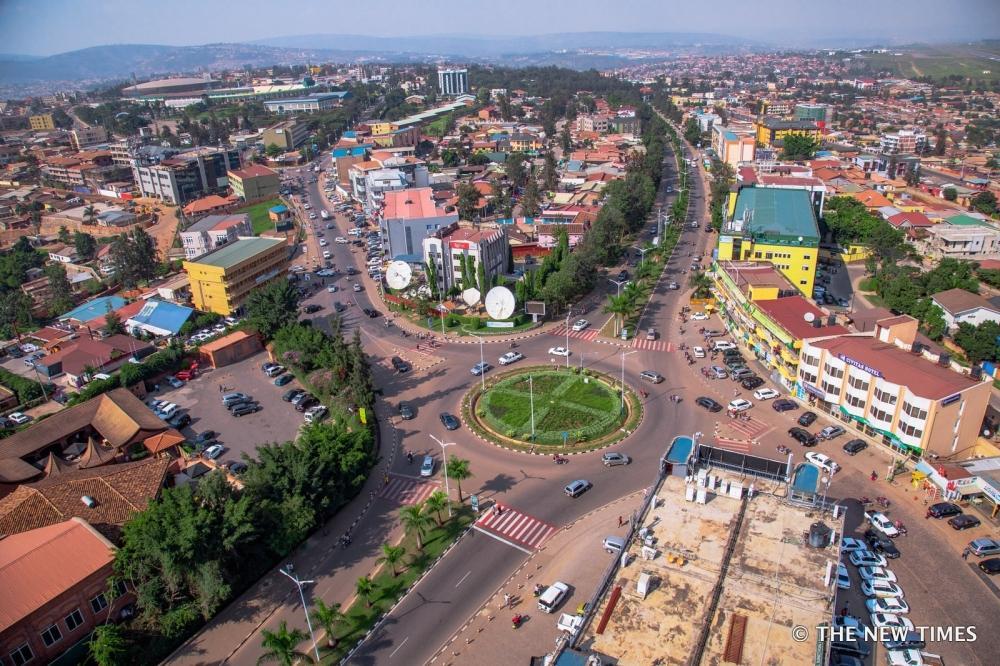Africa-Press – Rwanda. The City of Kigali has unveiled plans to enhance its urban road infrastructure, focusing on improving 11 key road junctions and developing facilities to support non-motorized transport and e-mobility initiatives.
Key junctions set for upgrades include Chez Lando, Gishushu, and Kicukiro/Sonatubes, along with Gisozi (Kinamba area), Nyabugogo, Rwandex, and Kibagabaga. The project also aims to introduce designated bus and cyclist lanes, overhead pedestrian bridges, and improved accessibility for persons with disabilities.
At Chez Lando junction, an underpass will allow motorists traveling from Gishushu to Kigali International Airport to pass beneath overhead traffic. Gishushu junction will feature a 500-meter-long flyover bridge near Simba Supermarket, allowing buses to pass underneath, while Sonatubes junction will have an underpass from the Ministry of Health offices to the area near Rwanda Tourism University College.
Speaking to The New Times, Julien Allaire, a Kigali-based urban mobility expert who is the Head of International Operations at TRANSITEC Consulting Engineers Ltd, explained the rationale behind such infrastructures, noting that they are designed to respond to an emergency situation where, for example, many people in Kigali lose a lot of time every day in traffic jams.
However, for these infrastructures to make this possible, they have to be designed with a multi-modal approach, taking into account public transport and pedestrians.
“To effectively address traffic congestion, priority should be given to public transport along the corridors between Remera and the City Center. A well-structured public transport system can accommodate far more people in a single lane compared to private cars,” Allaire noted.
“If they are not designed with a car-centric approach, these infrastructures could have a major impact on neighbourhood life. Pedestrians and shops would be the first to suffer. Public transport is also likely to be one of the big losers, unless the inclusion of dedicated bus lanes is built into the plans from the outset,” he added.
Talking about the cyclist lanes, as well as efforts to ease movement of persons with disabilities, he lauded the work that has been done by Kigali so far in favour of pedestrians, referring to it as remarkable and an example for all African cities.
The Rwanda Transport Development Agency (RTDA) on March 24 launched the $100 million (Rwf140bn) project. Courtesy
“We need to continue in this direction, notably by improving the design of pedestrian crossings. For example, we need to encourage the creation of islands that allow people to cross in two stages,” he noted.
“As far as bicycles are concerned, we need to consider the fact that they can play a significant role in mobility systems, especially electrically-assisted bicycles. To better promote this mode of transport, cyclists need to be protected from car traffic,” he added.
However, specifically commenting on the overhead pedestrian bridges, he had doubts about their advantages. He pointed out that though they are made to allow cars to drive faster, they force pedestrians to make detours and climb the equivalent of two storeys on foot.
“In an urban environment, such footbridges are rarely justified. We need to succeed in creating safe pedestrian crossings managed by traffic lights that ensure a good balance with traffic flows,” he said.
In earlier interviews, other experts told The New Times about the significance of the Dedicated Bus Lane (DBL), a system that Rwanda is planning to pilot along the Central Business District-Rwandex-Sonatubes-Giporoso road, and subsequently deploy on its roads to ease public transport.
Dedicated bus lanes are special lanes reserved only for buses. The DBL system helps buses move faster because they don’t get stuck in traffic jam with other cars.
Alphonse Nkurunziza, a senior lecturer in transport planning at the University of Rwanda, highlighted that DBLs can enhance public transport efficiency “because the buses will move on schedule” and won’t be delayed by traffic jam.
“Imagine a bus carrying more than 60 people stuck in traffic yet those people are going to work. That is not something good for the economy. People need to reach their workplaces in time so that they can work,” he said.
For Chris Kost, an expert in public transport and Africa Program Director at the Institute for Transportation and Development Policy, believes DBLs can significantly shorten travel times and boost reliability for passengers. However, he pointed out that while DBLs are a good first step, “it is crucial for the city to move towards implementing a bus rapid transit (BRT) system without further delay.”
The BRT is a high-capacity public transport service that generally runs on multiple DBLs and corridors to avoid delays that slow bus services.
Looking at Kigali’s transport landscape in 10-20 years, Allaire noted that given the demographic and economic growth of the city of Kigali, it is essential to look ahead to 2035.
“With the number of cars on the road growing at a rate of over 10% a year, how can we anticipate mobility needs?” he noted.
“Kigali needs a public transport system with the capacity to meet the population’s travel needs. We should bear in mind this quote from Enrique Peñalosa, who was Mayor of Bogotá and spearheaded the Bus Rapid Transit project in 2000: ‘An Advanced City Is One Where the Rich Take Public Transport’,” he added.
For More News And Analysis About Rwanda Follow Africa-Press






